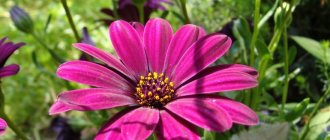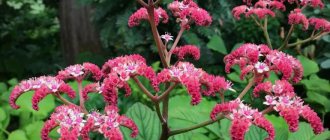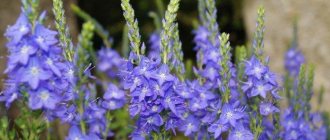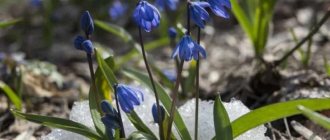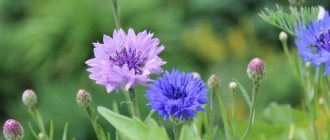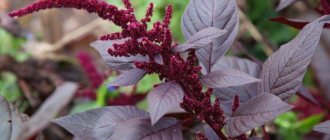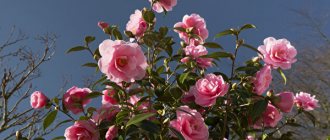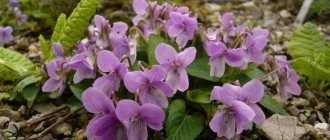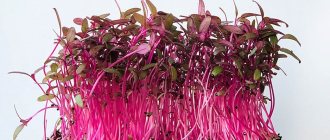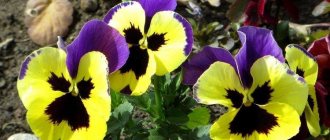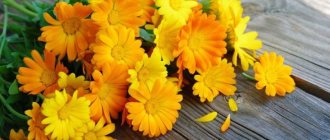Author: Elena N. https://floristics.info/ru/index.php?option=com_contact&view=contact&id=19 Category: Garden plants Published: March 07, 2018Last edits: November 04, 2020
- Growing conditions
- Chionodoxa forbesii
Chionodoxa (lat. Chionodoxa) are low-growing perennials of the Scylla genus of the Liliaceae family, of which 6 species are known. Chionodoxes grow in Asia Minor and on the island of Crete. The name of the genus is formed from two Greek words: “snow” and “pride, glory”, and among the people Chionodoxa is called “snow beauty” or “snowman”: this delicate plant with wonderful flowers appears along with woodlands and snowdrops when it is still lying on the ground snow.
Planting and caring for Chionodoxa
- Flowering: for 2-3 weeks in April, together with snowdrops and scillas.
- Planting: September-October.
- Lighting: bright sun or partial shade.
- Soil: loose. Moderately moist, well fertilized, neutral or alkaline reaction.
- Watering: only during drought, that is, if the winter was without snow and spring without rain. Watering is carried out early in the morning.
- Feeding: Nitroammophoska. Granular fertilizers are scattered over the area and incorporated into the soil through shallow loosening.
- Reproduction: by dividing the bulbous nest.
- Pests: meadow root mites and rodents.
- Diseases: gray mold, sclerotinia, fusarium, septoria and Achelenchoides.
Read more about growing Chionodoxa below.
general characteristics
Chionodoxa is a plant belonging to the genus Scilla of the Asparagus family. In total, the species has 6-8 representatives. The first mention of the flower appeared in 1877. The plant received its name in honor of the wife of the Swiss naturalist Pierre Emond Boissier, Lucille.
The height of the bushes is from 10 to 20 cm. Each flower has 2 lance-shaped leaf plates. The leaf length is up to 12 cm. The shade is dark green, rich.
Chionodoxa
Each bulb produces a peduncle, at the end of which there is a cluster of 3-5 buds. The average flower diameter is 4 cm. The color of the buds depends on the variety. Main shades: blue, deep blue, white, lilac, lilac and pink.
After flowering, the plant produces fruits - capsules with seeds. Flowers are propagated using the bulbous method.
Botanical description
Chionodoxa flowers are bulbous plants with two basal leaves appearing simultaneously with the peduncles - dark green, broadly lanceolate, grooved, 8-12 cm long. The peduncles bear loose racemose inflorescences of bell-shaped six-petaled flowers of white, blue, indigo or pink. The fruit of the plant is a juicy capsule in which black Chionodoxa seeds ripen. The ovoid bulbs, up to 3 cm long and up to 1.7 cm in diameter, are covered with light scales and are designed for two annual cycles.
Chionodoxa – photo
Most often, blue Chionodoxa are found in the areas. But pink, lilac and white varieties look no worse. And how adorable they are all together!
Photo: prorastet.ru
Photo: cveti-rasteniya.ru
Photo: flowersfamily.ru
Photo: 7dach.ru
Photo: pinterest.ru
Photo: zen.yandex.ru
Photo: m.nn.ru
Photo: flowerbulbs.com
Photo: pinterest.ru
Photo: plantarium.ru
Photo: elena-zhzhenova.livejournal.com
Photo: fotoload.ru
Photo: zen.yandex.ru
Photo: macgardens.org
Photo: sadgrad.ru
Photo: soncesad.com
Photo: domashniecvety.ru
Photo: pinterest.com
Photo: nat-geo.ru
Photo: my.topic.lt
Photo: planetalsad.com
Photo: planetalsad.com
Photo: wallpapersgood.ru
Photo: pexels.com
Did you like the post? Subscribe to our channel in Yandex.Zen, it really helps us in our development!
Planting Chionodoxa in open ground
When to plant
It is best to plant Chionodoxa bulbs in early autumn, when root ridges have formed on their bottoms. The plant grows well both in sunny areas and in partial shade. If you want early flowering, plant the bulbs where the snow melts first. When grown in partial shade, flowering of Chionodoxa may begin a little later than in the sun, but will last longer. You can plant these plants even under trees and bushes, because when Chionodoxa blooms, there are still no leaves on the bushes and trees that absorb the light that primroses need for growth and flowering.
Chionodoxa in open ground is best adjacent to plants such as primroses, hellebores, hyacinths, crocuses, pushkinias, white flowers, adonis and dwarf irises.
- Tulips after flowering: how to dig and store
How to plant
The soil on the site for Chionodoxa should be neutral or slightly alkaline, loose, moderately moist and well fertilized. The plant will settle in well and develop well if you add a little forest soil with rotted leaves and fragments of tree bark into the soil.
Planting Chionodoxa is carried out like planting any bulbous plant. How close and how deep to place Chionodoxa bulbs depends on their size. Large specimens are buried 6-8 cm, placing them in a row at a distance of 8-10 cm from each other. Smaller bulbs are buried 4-6 cm, keeping an interval of 6-8 cm between them.
Use in landscape design
Chionodoxes look great in the garden, they look better when they are planted in a large group:
- in rocky gardens, rock gardens;
- excellent for spring perennial flower beds in combination with other spring flowers - blueberries, snowdrops, crocuses, pushkinia;
- in close proximity to colorful hyacinths, chionodoxes look very attractive;
- can be planted in groups on the lawn - when planted on the lawn they create colorful islands;
- between ornamental shrubs;
- under deciduous trees.
In favorable conditions, plants can grow rapidly, forming extensive carpets in old gardens.
Chionodoxes look good in pots on terraces and balconies.
Due to its high frost resistance, lack of special care conditions and ease of cultivation, you should become interested in this beautiful original plant and allocate a place for it in the garden.
Caring for Chionodoxa in the garden
Growing conditions
Planting and caring for Chionodoxa will not be difficult for you, since this flower is one of the most unpretentious early flowering plants. You will only need to water the flower garden if there was no snow in the winter and no rain in the spring. After moistening, you need to carefully loosen the soil around the plants, while removing weeds. To do this less often, mulch the surface of the area with humus or dry peat. Caring for chionodoxes includes fertilizing and replanting the plant, as well as, if necessary, treating the flower garden against pests or diseases. If you do not want Chionodox to reproduce by self-sowing, pick off their testes before they are ripe.
Watering and fertilizing
Systematic abundant watering is very important for Chionodoxa in dry weather. The soil is moistened early in the morning so that drops do not fall on the flowers. The water should not be cold and settled.
Mineral complexes are used as fertilizer, for example, Nitroammofoska, when applied in early spring, Chionodoxa responds with lush and long flowering. Granular fertilizers are scattered over the area, after which the surface is loosened shallowly so that it is quickly absorbed by the root system of the plants.
Transplantation and propagation
The easiest way for Chionodoxa to reproduce is vegetatively - by separating children from the mother's bulb, which grow from 2 to 4 in one season. In one place, Chionodoxa can grow for up to ten years, but it is better to dig up nests once every 5-6 years, separate them and seat. The bulbs need to be removed from the soil in the second half of July, when the above-ground part of the plant turns yellow and dries out. And the bulbs are planted in the ground, as we have already written, at the end of August or beginning of September, so before planting the nests are stored in a dry, dark place at a temperature of 15-17 ºC. Do not separate the babies from the mother bulb immediately after removal from the soil, because during storage the smallest of them may die. It is better to divide the nest before autumn planting, which is carried out according to the scheme we have already described.
- Borage (borage): planting and care, properties
It is not advisable to grow Chionodoxa by seed, since they reproduce well by self-sowing: the seeds have a fleshy structure that is very popular with ants, who take the seeds far beyond the site. Chionodox from seeds bloom in 2-3 years.
Chionodoxa in winter
After flowering is completed, the chionodox shoots are cut off, but the leaves, as already written, are removed only after they wither - in the second or third decade of July. Chionodoxa tolerates winter frosts without any problems, but if you planted it in an open area, it is better to cover it with a heap of dry leaves or cover it with spruce paws for the winter. Although in the southern regions this precaution is unnecessary.
Reproduction
Chionodoxa can reproduce by self-sowing, seeds, and bulbs. But it is worth considering that after 4-5 years of growing in one place, the plants go wild. To maintain cultural qualities, breeders advise propagating chionodoxes using the bulbous method. During the season, the plant grows 2-4 new bulbs. At the end of July, when the plant closes all the inflorescences and the above-ground part withers (this means that the plant goes into a dormant state), dig up the mother bulb along with the “babies” and place it in a dry, cool place. The “kids” are separated immediately before planting in the soil.
If you don’t want to bother with digging up the bulbs, carefully dig up the plant completely and move it to another place as quickly as possible so that the roots do not dry out.
Despite the fact that the seed pods ripen in some varieties, propagation by seeds does not produce results in 90% of cases. Such flowers do not take root and do not produce inflorescences.
Plants reproduce well by self-sowing. The fleshy grains are loved by ants, who take them all over the area. Flowers begin to bloom after a couple of years.
Pests and diseases
Like any other bulbous plant, Chionodoxa is susceptible to fungal diseases such as gray rot, sclerotinia, fusarium, septoria and Achelenchoides. The problem is that these diseases affect the bulb located underground, and we observe, as they say, the last act of the performance - yellowing and drying of the leaves, but we no longer have time to save the plant. Therefore, it is advisable to treat the planting material before planting in a Fundazol solution and observe moderation when watering, avoiding stagnation of water and, as a result, rotting of the bulbs.
The most dangerous pests for Chionodoxa are the larvae of root meadow mites and rodents that damage plant bulbs. Treating the plant with acaricidal preparations (Aktara, Akarin, Actellik, Agravertin and the like) is effective against ticks, and mice and moles are gotten rid of by spreading poisoned baits around the area.
Landing at the site
Perennial garden geranium - planting and care in open ground
When growing Chionodox primroses, planting and care in open ground play an important role for lush flowering. Bulbs are planted in the first weeks of September.
Procedure:
- The site chosen is fertile with neutral acidity. The soil is first dug up. Turf, sawdust, and humus are embedded in the soil.
- In the prepared flowerbed, holes are dug at intervals of 10 cm. Depending on the size of the bulbs, the depth of the holes ranges from 5 to 10 cm.
- The bulbs are placed in the center of the hole and covered with soil.
- The seedlings are shed with water and fed with nitrogen-containing fertilizers.
Types and varieties
As already mentioned, scientists have described six species of Chionodoxa, but only three of them are grown in culture, as well as varieties and hybrids of different plant species.
Chionodoxa forbesii
Or Chionodoxa tmolusi is found naturally in southern Turkey. This species reaches a height of 25 cm. The plant forms a loose raceme on the peduncle, consisting of up to 15 white or pink flowers. This species does not produce seeds, but the bulbs grow annually as children. Chionodoxa Forbesia has been in culture since 1976. The following cultivated plant varieties are known:
- Alba - chionodoxa with snow-white flowers;
- Chionodoxa Blue Giant - a variety with perianths of intense blue color;
- Pink Giant is a garden form with lavender-pink flowers.
Chionodoxa luciliae
Or the giant chionodoxa (Chionodoxa gigantea) is named after Lucille Boissier. Chionodoxa grows in the mountains of Asia Minor, reaching a height of only 20 cm. The leaves of plants of this species are grooved and linear. Flowers, up to 3 cm in diameter, blue-blue with a white throat, are collected in inflorescences in quantities of up to 10 pieces. The species has been in cultivation since 1764. The following varieties of Chionodoxa Lucilia are popular:
- Winter juniper cuttings are an even more effective way
- white - a plant up to 10 cm high with white flowers up to 2.5 cm in diameter, of which there are 3-4 in one brush;
- pink – the color of the flowers is pink with a slight purple tint.
Gardeners are interested in a variety of pink variety - Chionodoxa Rose Queen (aka Rosie Queen or Pink Queen), the flowers of which are distinguished by a very beautiful shade of pink.
There is another variety of Chionodoxa Lucilia - a giant white one with flowers up to 4 cm in diameter.
Chionodoxa sardensis
also native to Asia Minor. This is a plant with two linear leaves, strong peduncles up to 12 cm high, which bear up to 10 bright blue flowers up to 2 cm in diameter, collected in a loose raceme. The plant has been in cultivation since 1885. The species has garden forms with white and pink flowers.
Also known are Chionodoxa dwarf, or Cretan, Chionodoxa whitish and Mrs. Lock, which were used to obtain new varieties, but have not yet been introduced into cultivation. With the participation of different species of Chionodoxa, breeder V. Khondyrev created a series of wonderful hybrids: Watercolor, Artemis, Absolute, Atlantis, Andromeda, Aphrodite and Arctic. Hybrids between related plants Chionodoxa Forbes and Scylla bifolia, which are called Chionoscilla, are also popular. They do not exceed 10 cm in height, and their small blue star-shaped flowers are formed not into loose inflorescences, like those of Chionodoxa, but into dense inflorescences.
general information
The perennial lily chionodoxa is common in Crete and in certain regions of Asia. She blooms at the same time as snowdrops, for which she is nicknamed the snow queen.
Chionodoxa looks like a classic bulbous primrose. It has several long lanceolate leaves right at the root, and graceful star-shaped flowers of 6 petals are grouped in loose racemes. Chionodoxa bulbs are very small - up to 3 cm in length and almost half as wide.
Photo: ocean-sp.ru
When and how does it bloom
Chionodoxa is an early perennial. Its flowering usually begins in April, when it gets warmer outside. Some varieties have a later date and occur in May.
The color of the plant is different, but all shades are calm. Flowers are white, blue, blue, pink, lilac, purple.
The color of Chionodoxa flowers is uneven - there is a light spot in the center, towards the tips of the petals the shade becomes darker and more saturated
Flowering lasts only 2-3 weeks. The growing season ends at the beginning of summer with the death of the aboveground part of the plant.
Fertilizer and feeding
After an early flowering crop has formed shoots and flower stalks have barely appeared on the surface of the soil, the plant’s need for feeding increases. Typically gardeners use nitrogen.
Attention! Fertilizer is carefully scattered around the flowers. It is important to ensure that it does not get on the leaves, otherwise it can cause a burn!
Then the top layer of soil is slightly loosened. This stimulates air and water exchange, and also leads to faster and better absorption of nutrients by rhizomes.
Features of agricultural technology
Chiondochoxa are resistant to adverse natural phenomena and easily take root when transplanted.
Planting in open ground
Basic procedures for caring for Chionodoxa:
- Lighting. Plants are light-loving. Flowers prefer light areas or slight shade.
- Watering. Flowers need moderate watering in the morning. Use settled, warm water.
- Mulching. Flowers respond positively to this procedure. Fir needles and moss are used as mulch.
- Loosening. The process improves soil aeration. Loosening is combined with weeding and carried out the next day after watering or heavy rain.
- Feeding. Complex fertilizers are applied 2-3 times per season. Dry mixtures are evenly distributed over the area, mixed with the soil during loosening.
- Transfer. It is recommended to replant plants at the end of July. They are dug up along with the bulbs and stored in a cool, dark place. Plants are planted in a permanent location in the fall.
- Wintering. In regions with severe frosts and winds, when the temperature drops to 5 degrees below zero, cover the flower beds. Bushes left without shelter are mulched with pine needles or covered with spruce branches.
Important! When watering, water is directed to the root. Moisture on the leaf blades and inflorescences adversely affects the appearance of the flowers.
Features of flowering
Chionodoxes are classified as primroses. Their flower stalks form in mid-spring. The flowering is lush. When planting crops in shaded areas, flower stalks last longer. In Chionodoxa Blue Giant, flowering continues for 20 days. The giant Chionodoxa Alba also blooms for a long time.
On average, no more than 14 days pass from the moment of blooming to the moment the peduncle wilts. The buds of some hybrids bloom in stages. An example of such a plant is Chionodoxa variety Luc Rosea. Thanks to this feature, gardeners enjoy flowering for a month.
